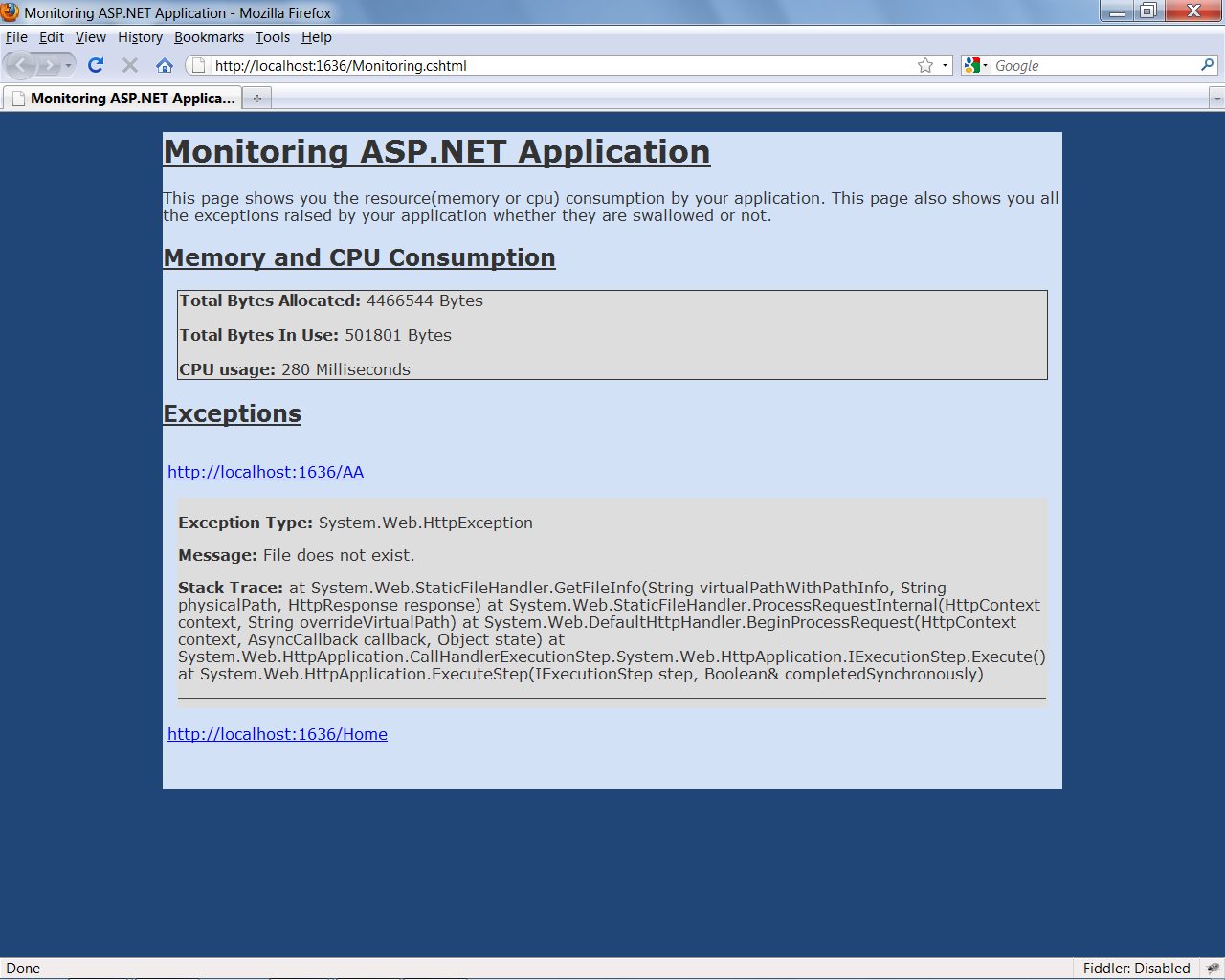Monitoring ASP.NET Application
Introduction:
There are times when you may need to monitor your ASP.NET application's CPU and memory consumption, so that you can fine-tune your ASP.NET application(whether Web Form, MVC or WebMatrix). Also, sometimes you may need to see all the exceptions(and their details) of your application raising, whether they are handled or not. If you are creating an ASP.NET application in .NET Framework 4.0, then you can easily monitor your application's CPU or memory consumption and see how many exceptions your application raising. In this article I will show you how you can do this.
Description:
Update: This package is now available on NuGet. To install this, just type Install-Package MonitorAspNetApplication in the Package Manager Console
With .NET Framework 4.0, you can turn on the monitoring of CPU and memory consumption by setting AppDomain.MonitoringEnabled property to true. Also, in .NET Framework 4.0, you can register a callback method to AppDomain.FirstChanceException event to monitor the exceptions being thrown within your application's AppDomain. Turning on the monitoring and registering a callback method will add some additional overhead to your application, which will hurt your application performance. So it is better to turn on these features only if you have following properties in web.config file,
1 | <add key="AppDomainMonitoringEnabled" value="true"/> |
2 | <add key="FirstChanceExceptionMonitoringEnabled" value="true"/> |
In case if you wonder what does FirstChanceException mean. It simply means the first notification of an exception raised by your application. Even CLR invokes this notification before the catch block that handles the exception. Now just update global.asax.cs file as,
01 | string _item = "__RequestExceptionKey"; |
02 | protected void Application_Start() |
07 | private void SetupMonitoring() |
09 | bool appDomainMonitoringEnabled, firstChanceExceptionMonitoringEnabled; |
10 | bool.TryParse(ConfigurationManager.AppSettings["AppDomainMonitoringEnabled"], out appDomainMonitoringEnabled); |
11 | bool.TryParse(ConfigurationManager.AppSettings["FirstChanceExceptionMonitoringEnabled"], out firstChanceExceptionMonitoringEnabled); |
12 | if (appDomainMonitoringEnabled) |
14 | AppDomain.MonitoringIsEnabled = true; |
16 | if (firstChanceExceptionMonitoringEnabled) |
18 | AppDomain.CurrentDomain.FirstChanceException += (object source, FirstChanceExceptionEventArgs e) => |
20 | if (HttpContext.Current == null) |
22 | if (HttpContext.Current.Items[_item] == null) |
23 | HttpContext.Current.Items[_item] = new RequestException { Exceptions = new List<Exception>() }; |
24 | (HttpContext.Current.Items[_item] as RequestException).Exceptions.Add(e.Exception); |
28 | protected void Application_EndRequest() |
30 | if (Context.Items[_item] != null) |
33 | var reqExc = Context.Items[_item] as RequestException; |
34 | reqExc.Url = Request.Url.AbsoluteUri; |
36 | if (Application["AllExc"] == null) |
37 | Application["AllExc"] = new List<RequestException>(); |
38 | (Application["AllExc"] as List<RequestException>).Add(reqExc); |
Here is the simple RequestException class,
1 | public class RequestException |
3 | public string Url { get; set; } |
4 | public List<Exception> Exceptions { get; set; } |
Now browse to Monitoring.cshtml or Monitoring.aspx file, you will see the following screen,

The above screen shows you the total bytes allocated, total bytes in use and CPU usage of your application. The above screen also shows you all the exceptions raised by your application which is very helpful for you. I have uploaded a sample project on github at here. You can find Monitoring.cshtml and Monitoring.aspx file on this sample project. You can use this approach in ASP.NET MVC, ASP.NET WebForm and WebMatrix application.
Summary:
This is very important for administrators/developers to manage and administer their web application after deploying to production server. This article will help administrators/developers to see the memory and CPU usage of their web application. This will also help administrators/developers to see all the exceptions your application is throwing whether they are swallowed or not. Hopefully you will enjoy this article too.
